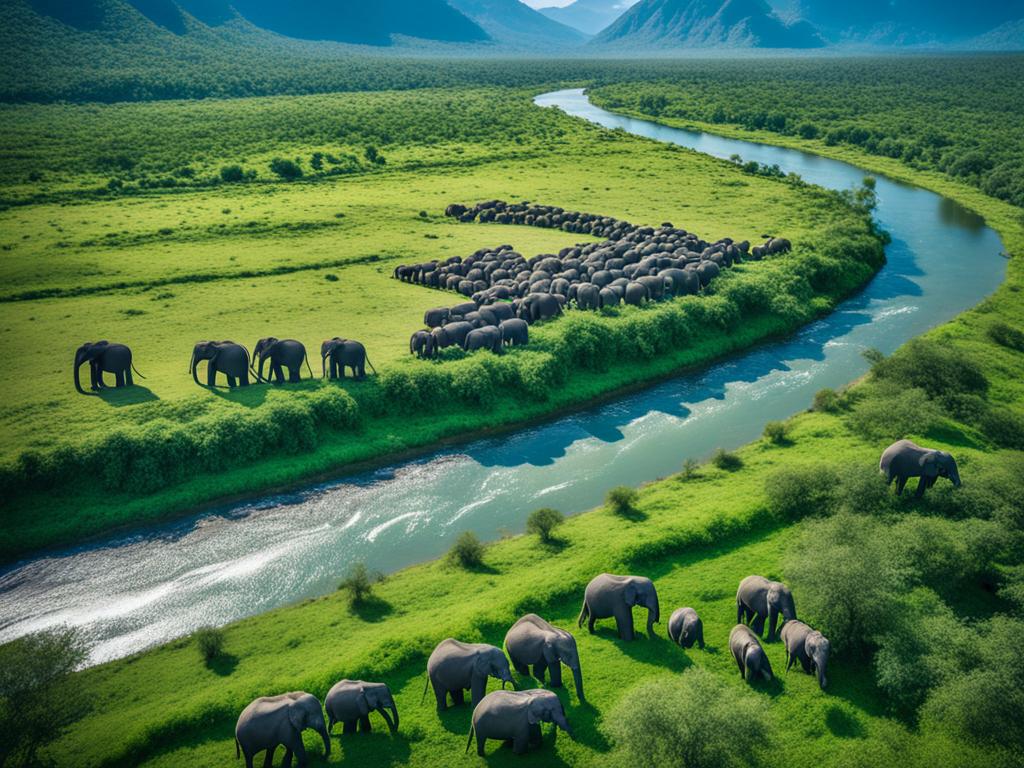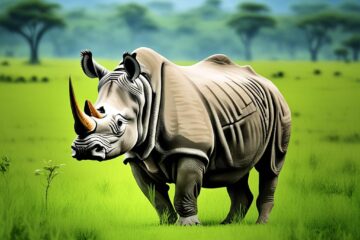The sun set behind the baobab trees as Sarah watched, amazed. She was in Botswana’s Chobe National Park, ready to see its famous elephant herds. On a safari by the Chobe River, excitement filled the air.
Soon, Sarah saw a movement far off. She gasped at the sight of a great herd of elephants appearing from the greenery. They moved as one to the river, a scene of awe-inspiring beauty. Botswana’s dedication to protecting its wildlife was clear in the number of elephants before her.
Watching the elephants, Sarah felt something special. She saw how they cared for their family, from mothers and babies to lively young ones. She gained a deep respect for the elephants’ complex social lives.
Key Takeaways
- Botswana is renowned for having one of the largest concentrations of elephants in Africa.
- Chobe National Park is a prime destination for witnessing the impressive herds of elephants that gather along the Chobe River.
- Observing the elephants’ social interactions and behaviors offers a unique and captivating insight into their complex world.
- Botswana’s commitment to wildlife conservation has played a crucial role in the growth and protection of its elephant population.
- Visiting Chobe National Park provides an opportunity to immerse oneself in the splendor of Botswana’s natural wonders and appreciate the majesty of its abundant elephant herds.
Introduction to Botswana’s Elephant Population
Botswana has more elephants than any other country, about 130,000. Its strong focus on saving wildlife has helped these numbers grow. It has also kept its Botswana elephant population safe.
Botswana’s Conservation Efforts
For a while now, Botswana has stood out for taking great care of its elephants. The country made rules against poaching and set up safe zones. It worked closely with others worldwide to protect its elephant significance Botswana.
The Significance of Elephants in Botswana
In Botswana, elephants are much more than animals. They’re symbols of power, wisdom, and the national spirit. They are vital for the environment, shaping the land and helping many other animals live.
Chobe National Park: A Haven for Elephants
In the north of Botswana, there’s a place called Chobe National Park. It’s a top spot for seeing amazing elephant herds. This huge area is famous for its different landscapes. They make a perfect home for many elephants near the Chobe River.
Exploring the Diverse Landscapes of Chobe
Chobe is full of different lands. There are lush forests by the river, vast savannas, and dry woods. You can see these varied Chobe landscapes in many ways. Try guided drives, boat trips, or walk safaris to find wildlife and beauty.
Best Time to Visit for Elephant Sightings
The best time to see lots of elephants at Chobe is in the dry winter. This season runs from May to October. Elephants gather near the Chobe River during these months. They come for the water and green food. It’s a great time to visit if you love elephants.
Elephant Behavior and Interactions
Watching elephants at Chobe National Park is a real eye-opener. You get a deep look into their lives and behaviors. They live in amazing social groups and show unique actions. The elephants in Botswana share a lot about their world with us.
Family Dynamics and Social Structures
Elephants form strong family ties, usually with a lead female. Each group is like one big, caring team. Adults and young elephants work together to keep everyone safe. If you visit Chobe, seeing how elephants bond and help each other is unforgettable.
Unique Elephant Behaviors to Observe
Elephants not only live together in big families but also act in interesting ways. You might see them using their trunks to show love or even hear their loud calls for group planning. Observing these actions at Chobe National Park is truly special.
| Elephant Behavior | Description |
|---|---|
| Trunk Touching | Elephants use their trunks to gently touch and caress other herd members, a behavior that is thought to strengthen social bonds and communicate affection. |
| Dust Bathing | Elephants will often flick dust and soil over their bodies, a behavior that is believed to help regulate their body temperature and protect their skin from the sun. |
| Rumbling Vocalizations | Elephants produce a wide range of vocalizations, including low-frequency rumbles, that are used to communicate with other herd members and coordinate their movements. |
| Coordinated Drinking | Elephants will often drink water in a coordinated fashion, with the herd members taking turns and ensuring that the entire group is able to access the available water sources. |
Responsible Elephant Viewing and Tourism
As Chobe National Park becomes more popular, understanding how to view elephants responsibly is key. This helps protect these amazing animals. Following the right steps for respsonsible elephant viewing makes you a part of safeguarding Botswana’s elephants.
Ethical Guidelines for Visitors
For a sustainable and positive experience with elephants, always follow these important steps:
- Maintain a respectful distance: Watch elephants from a distance that’s safe for you and them, keeping them calm and comfortable.
- Avoid approaching or touching: Stay away and do not try to touch the elephants. This protects their natural habits and keeps you safe.
- Respect herd dynamics: Observe how elephant families interact without disturbing them. Let them be.
- Follow park regulations: Stick to Chobe National Park’s rules to protect the elephants and their homes.
- Support conservation efforts: Help out local conservation efforts. This protects Botswana’s elephants and their land.
By keeping these ethical rules in mind, you help protect these stunning animals. You also make your visit more meaningful and safe.
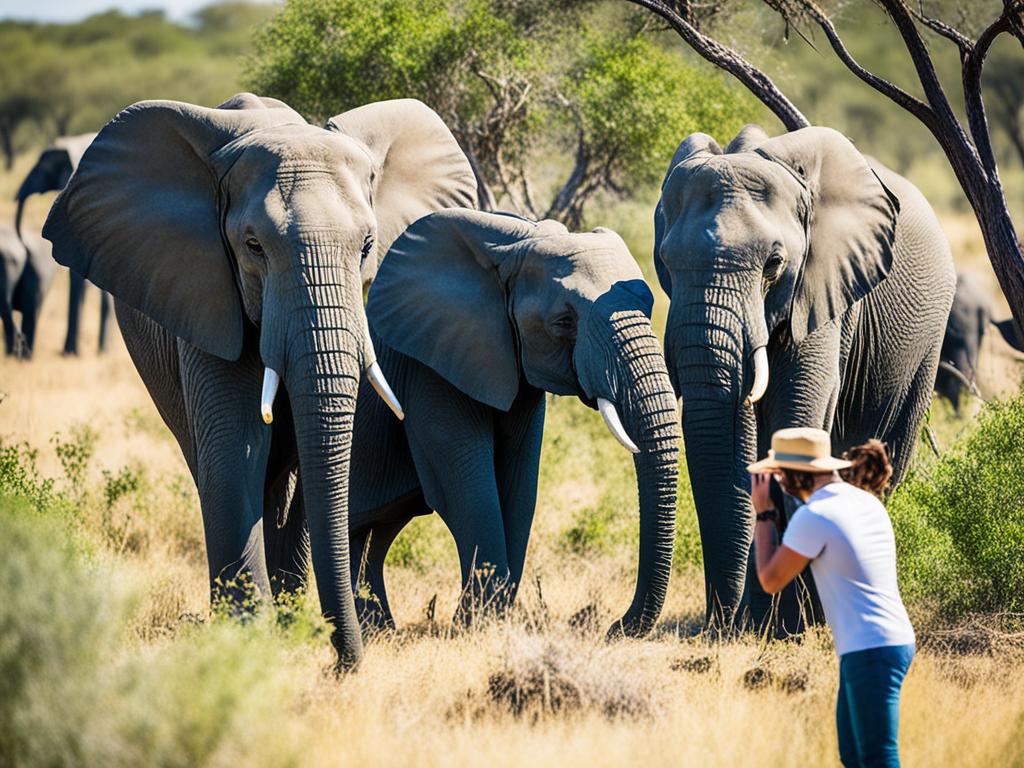
The Importance of Elephant Conservation
Conserving elephants is crucial, not just in Botswana, but across Africa. Chobe National Park stands as a large area where many elephants live. It shows Botswana’s strong commitment to saving wildlife and marking their role in nature.
Threats Facing Elephant Populations
Even with efforts in Botswana, elephant numbers still struggle. They face dangers like losing their homes, conflicts with humans, and being hunted. Tackling these issues is key to keeping elephants safe for the future.
Conservation Initiatives and Organizations
Botswana leads in elephant protection, using many plans to help them. They work with groups worldwide that focus on conservation. They also fight against poachers and support tourism that cares for the animals.
Capturing Elephants on Camera
At Chobe National Park, you can find many elephants. This makes for a great chance to take amazing photos. If you love taking pictures, or are just starting out, Chobe is perfect for elephant photography. You’ll get to make photos that show how beautiful and grand these animals are.
Photography Tips and Techniques
Want to get great pictures in Chobe? Here are some tips:
- Know your camera well for quick shots, like elephants moving.
- Try many angles for the best photos. A lower view can show how big elephants are.
- Check the light and adjust your camera to make your photos bright and clear.
- Watch the elephants and take photos when they’re doing something special.
Memorable Elephant Encounters
Visiting Chobe means more than just elephant photography. You’ll see fantastic stuff, like how elephant families interact. Watching them drink, bathe, and play is unforgettable. Use your camera to remember these amazing moments with the elephants.
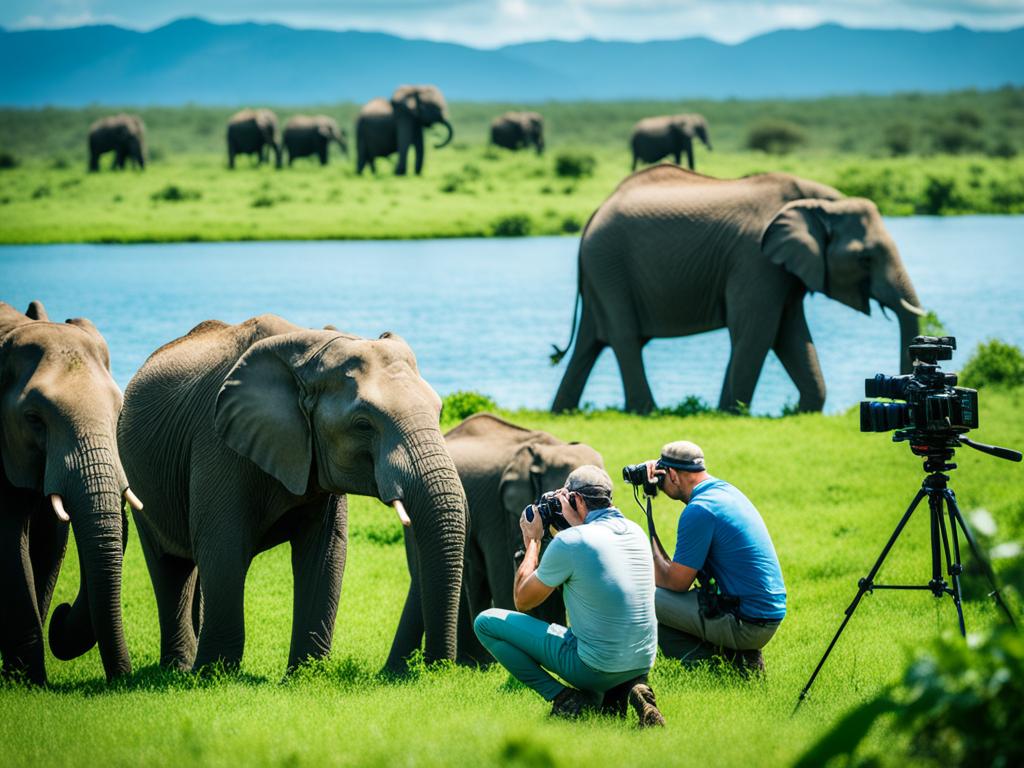
Botswana’s Other Wildlife Attractions
Botswana wildlife attractions, like Chobe National Park, are famous for their many elephants. However, the country offers much more wildlife that’s exciting to see. It has a variety of environments, from open savannas to peaceful wetlands. This supports a mix of animals that draw visitors worldwide.
Botswana shines in its numbers of big cats, including lions, leopards, and cheetahs. Besides, you can meet giraffes, rhinos, and fast antelopes. All these animals are key to keeping the natural order in balance.
The Okavango Delta, honored as a UNESCO World Heritage Site, shows a beautiful blend of land and water life. There, you’ll find African buffaloes, zebras, and hippos, along with other animals. This delta area is rich and full of life.
Head to the Kalahari Desert for a unique wildlife experience. You might see the tough black-maned lions, elusive brown hyenas, and interesting wild dogs. They’re all part of the amazing but challenging desert scene.
Botswana’s collection of wildlife attractions is perfect for nature lovers. Here, one can really understand the deep connections between different species. The country works hard to keep its wildlife safe for the future.
Cultural Experiences in Botswana
Botswana is not just about its amazing wildlife seen in Chobe National Park. It also offers cultural experiences to dive into. You can learn about its traditional customs, attend lively festivals, taste the delicious local cuisine, and see beautiful crafts. These aspects show the diverse and strong spirit of the people in Botswana.
Traditional Customs and Festivals
In Botswana, traditional customs are more than just practices. They connect people to their past and each other. The country is full of life during festivals that reflect its culture. For example, the Domboshaba Festival shares the Kalanga people’s ways with music, dance, and stories.
Local Cuisine and Crafts
Botswana’s food mixes flavors from Africa and around the world. You’ll find tasty dishes like seswaa, motogo, and morogo. Its crafts are also exceptional, with things like woven baskets, pottery, and beadwork. You can discover these at local markets and craft workshops.
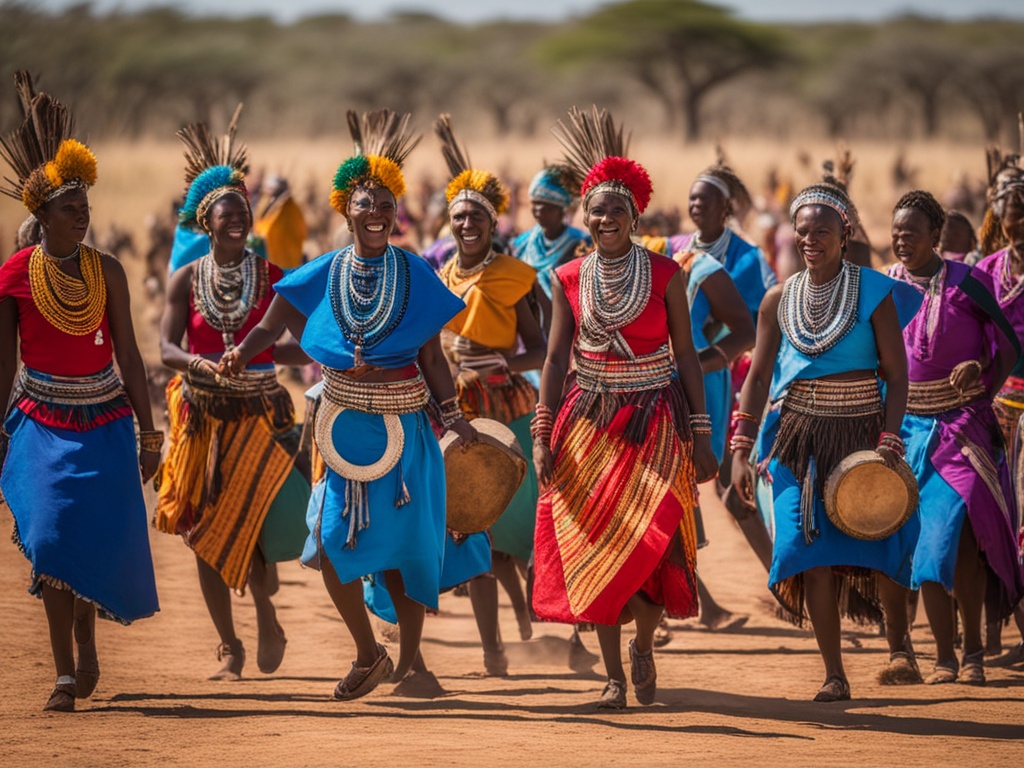
| Botswana Cultural Experiences | Description |
|---|---|
| Traditional Customs | Deeply rooted in Botswana’s history and vital to daily life |
| Festivals | Vibrant celebrations that showcase the rich cultural heritage |
| Local Cuisine | Flavorful blend of African and international influences |
| Crafts | Intricate basket weaving, pottery, and beadwork |
Planning Your Botswana Safari Adventure
Starting a safari in Botswana needs some good thinking. You want it to be a memory that sticks. This guide will help you pick the best places to stay and how to get around. It’s all about making your time in Botswana awesome.
Accommodation Options
In Botswana, you can find a place to stay that fits your style and wallet. There are fancy lodges with amazing river views and tented camps that let you live close to the wild. Most places take caring for the earth seriously. This means your visit helps protect the environment.
Travel Tips and Essentials
Getting ready for your safari means knowing some important stuff and packing right. Botswana is mostly hot and dry. So, it’s smart to pack light, cool clothes, a hat, and good sunblock. Don’t forget bug spray to keep those mosquitoes away. Oh, and you’ll need some sturdy shoes for walking in Chobe National Park.
Thinking ahead about where to stay and what to bring will make your trip special. You’ll see amazing elephants and dive into the beautiful culture and nature of Botswana. It’s a place like no other.
